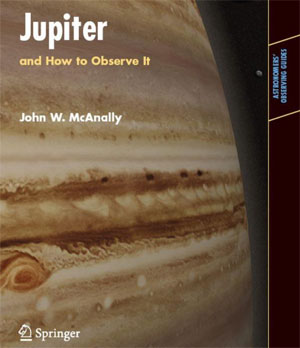 One of the real celestial treats through any size telescope is the giant planet Jupiter. Even a 2-inch scope will let you view its main markings and four largest moons. By watching the moons change their positions night after night, you can experience “real-time” astronomy.
One of the real celestial treats through any size telescope is the giant planet Jupiter. Even a 2-inch scope will let you view its main markings and four largest moons. By watching the moons change their positions night after night, you can experience “real-time” astronomy.
That would be a good start. If, however, you want to go deeper into Jupiter observations, I recommend Jupiter and How to Observe It by John W. McAnally (Springer, 2008).
Even before I started reading the chapters, I knew this book would be good because of the astroimagers McAnally lists in his acknowledgements. Most have contributed to Astronomy for many years, and, as photo editor, I’m well aware of the high quality of their work.
This book is the eleventh of Springer’s Astronomers’ Observing Guides. This series gathers and presents a wealth of information about specific astronomical subjects. As with the other ten books, Jupiter and How to Observe It divides into two parts.
Part 1 (chapters 1-6) presents an up-to-date detailed physical and astrophysical description for amateur astronomers who want to know all about what it is they’re observing. Part 2 (chapters 7-9) details observing and imaging techniques for practical astronomers working with a range of different instruments.
The images and illustrations throughout the book will really add to your understanding of the jovian processes you can observe. I was glad to see lengthy, explanatory captions. Combined with the pictures, they tell a story that parallels the text.
As for the text, it’s succinct and informative. If you’re new to Jupiter-watching, be sure to spend some time with Chapter 2, “Jupiter’s Place in the Solar System.” Here, you’ll learn the difference between a belt and a band, a region and a zone, and a nodule and an oval — all complete with sketches.
As a planetary sketcher myself, I appreciated the dozen pages devoted to sketching Jupiter in Chapter 9, “Making a Record.” Sketching is the great equalizer. It allows you to record faint details without the additional expense of cameras, computers, and software. It also makes you a better observer because you have to focus on small details, commit them to memory (albeit briefly), and transfer them to your note pad.
Jupiter and How to Observe It makes a great beginner’s reference and also functions as a refresher course for more seasoned planetary observers.